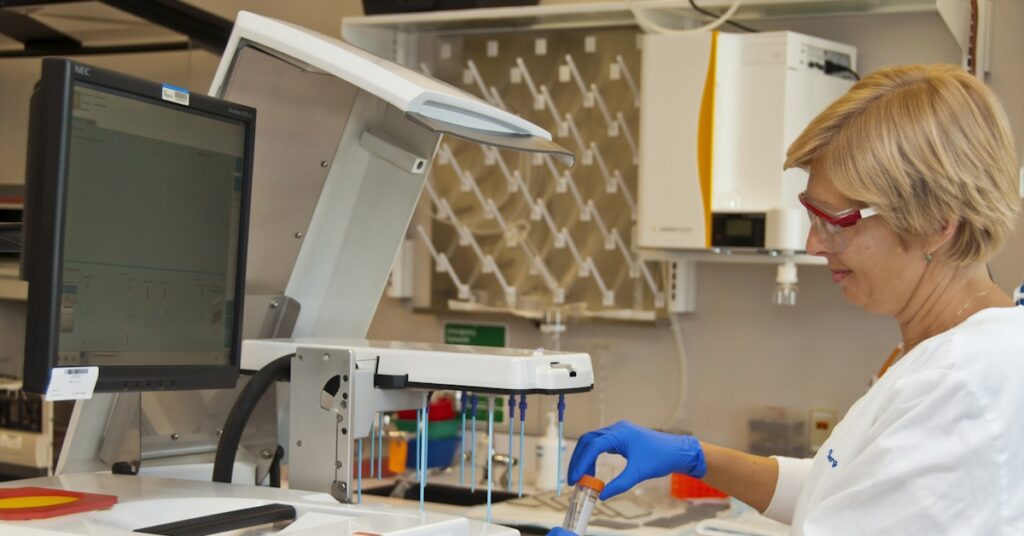Struggling to unify your development process?
Your teams use different tools for design, testing, and deployment. This creates workflow gaps and slows your release cycles, making scaling difficult.
The real issue is when disjointed systems create inefficiencies during rapid scaling, putting quality and compliance at risk with every new release.
This pressure to innovate while managing outdated workflows puts you in a tough spot. You’re forced to justify every new tool against tight budgets.
Speaking of financial efficiency, my guide on best credit management software explores tools to bolster cash flow and manage debt.
But what if you could find a single platform to streamline your entire lifecycle and bring your teams together without the headache?
In this guide, I’ll show you the best application lifecycle management software. We’ll cut through the vendor noise and focus on tools that truly unify DevOps.
You will discover how to scale quality, automate compliance, and achieve a faster time-to-market with the right ALM solution for your needs.
Let’s dive in.
Quick Summary:
| # | Software | Rating | Best For |
|---|---|---|---|
| 1 | Atlassian → | Growing mid-market companies | |
| 2 | Jama Software → | Complex product developers | |
| 3 | Broadcom → | IT directors & engineering managers | |
| 4 | PTC → | Product complexity managers | |
| 5 | Perforce → | Growing mid-market DevOps teams |
1. Atlassian
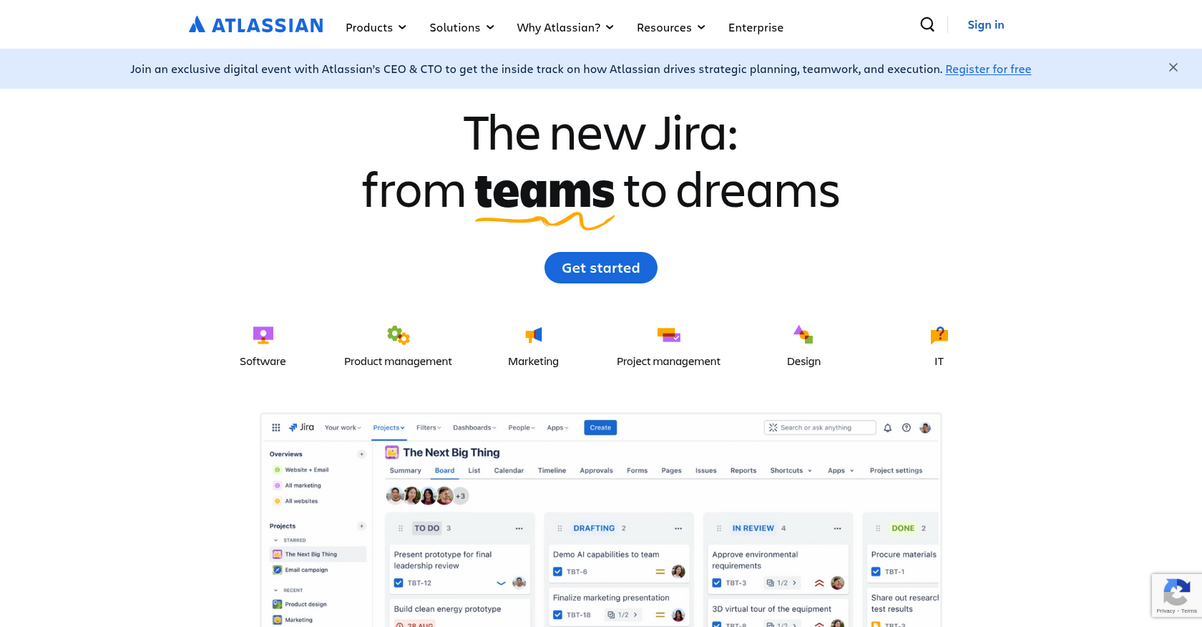
Are you struggling with fragmented development workflows?
Atlassian provides a connected cloud platform, like Jira for flexible project management, to unify your system of work. This means you can centralize everything.
Its offerings address challenges by providing a blueprint for how teams work together, ensuring your processes are transparent and efficient. It’s all about integrating your entire process.
Here’s how Atlassian helps.
Atlassian’s connected cloud platform serves as the foundation for your work, consolidating scattered documents and disconnected teammates. This ensures your knowledge is all in one place.
You can utilize tools like Jira for flexible project management and Bitbucket for collaborative code repositories. Jira Service Management also provides high-velocity service delivery, allowing your Dev and Ops teams to connect on a single platform. Plus, Loom offers quick video updates for better async collaboration, and Jira Product Discovery helps capture and prioritize ideas.
The result is streamlined end-to-end lifecycle management.
Speaking of strategic insights, my article on marketing analytics tools provides valuable information for data-driven decisions.
Key features:
- Flexible Project Management: Jira offers agile tools for planning, tracking, and delivering your biggest ideas, supporting Scrum, bug tracking, and DevOps templates.
- Unified Knowledge Hub: Confluence centralizes documentation and team knowledge, creating a single source of truth for all your project information and team collaboration.
- Collaborative Development: Bitbucket provides collaborative code repositories, while Compass elevates the developer experience, ensuring smooth code management and teamwork.
Atlassian features, pricing, & alternatives →
Verdict: Atlassian is ideal for growing mid-market companies seeking the best Application Lifecycle Management software, offering integrated tools like Jira, Confluence, and Bitbucket for unified visibility and streamlined workflows. With 80% of Fortune 500 companies trusting Atlassian, it’s a proven choice for scaling quality and accelerating time-to-market.
2. Jama Software
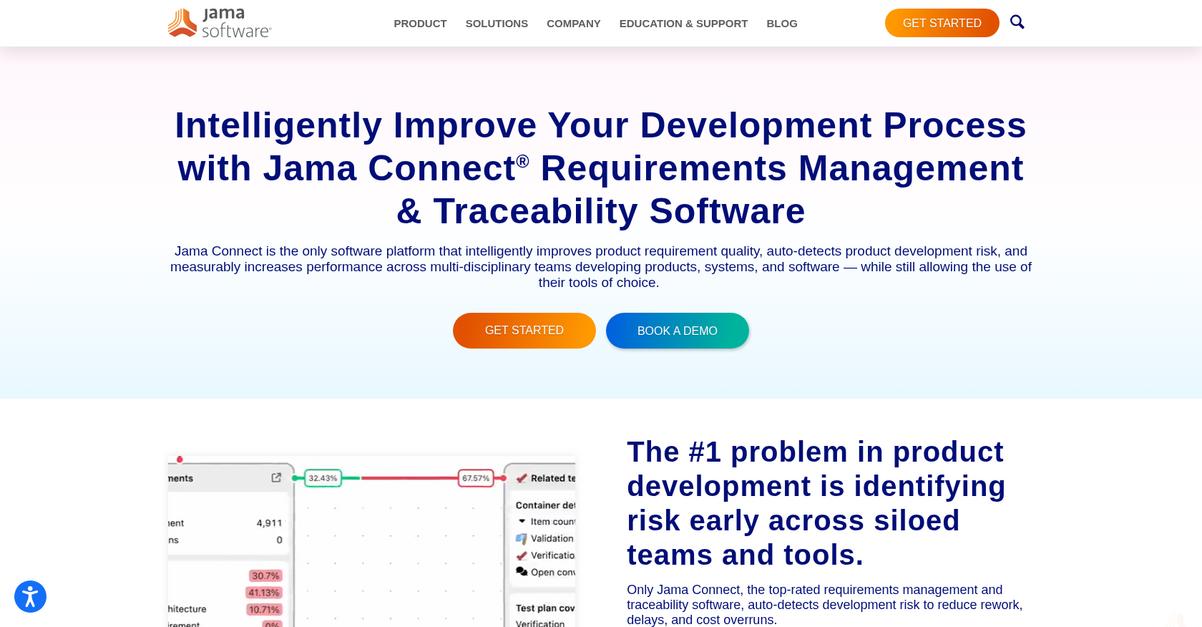
Is fragmented development hindering your team’s progress?
Jama Connect intelligently improves product requirement quality and auto-detects development risk.
This means you can identify poorly written, missing, or changed requirements, along with gaps in verification and validation test coverage, to measurably reduce defects, delays, and cost overruns.
Unlock your product’s full potential.
Jama Connect simplifies complex product, systems, and software development, enabling you to manage product complexity and scale efficiently. You can also unify test case management and maintain product state across various tools.
Additionally, it automates compliance efforts with frameworks and templates for industries like Medical Device, Automotive, and Aerospace & Defense, ensuring you meet standards without slowing down your development. This streamlines compliance and speeds up product development significantly. Plus, features like Trace Scores™ allow you to measure traceability, accelerating time to market and helping you identify defects two times faster while reducing test failures by nearly 3x.
The result is increased performance across multi-disciplinary teams.
Key features:
- Intelligent Requirement Improvement: Auto-detects product development risk, identifying poorly written, missing, or changed requirements to reduce rework and cost overruns.
- Unified Collaboration and Test Management: Brings all collaboration and reviews online while unifying test case management, maintaining product state across various tools.
- Automated Compliance and Scalability: Eliminates manual compliance efforts with industry-aligned frameworks and templates, offering proven scalability up to 10 million items per project.
Jama Software features, pricing, & alternatives →
Verdict: Jama Connect stands out as the best Application Lifecycle Management software by providing intelligent risk detection, robust traceability with Trace Scores™, and automated compliance, enabling your team to unify workflows, accelerate time to market, and reduce test failures by nearly 3x, making it ideal for scaling quality and unifying DevOps.
3. Broadcom
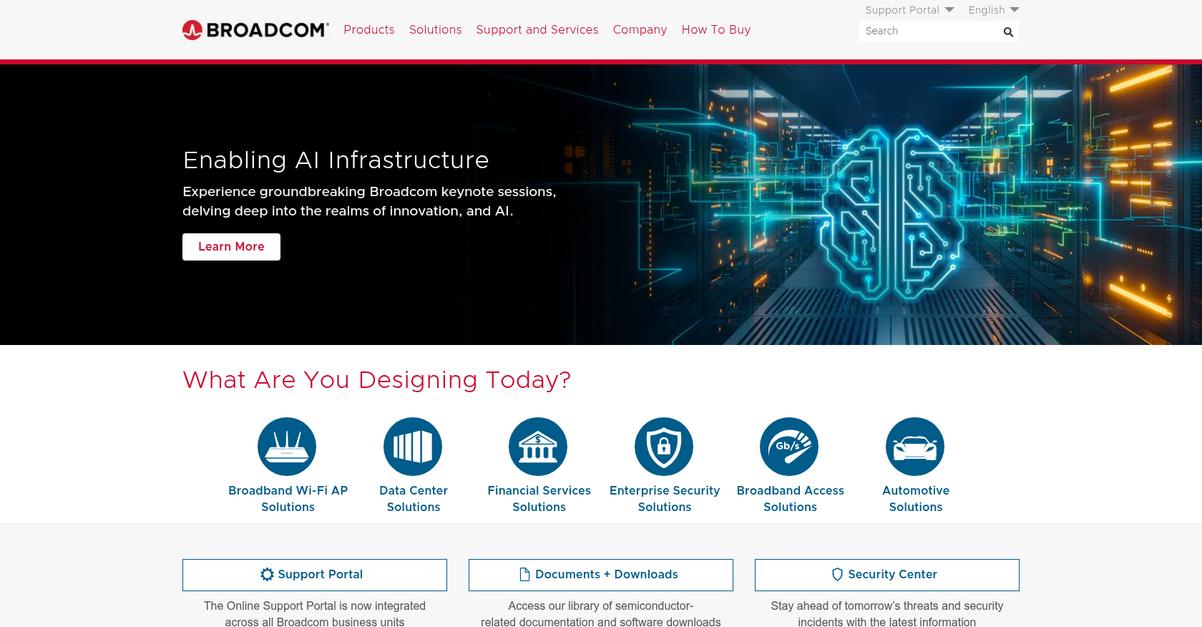
Is your DevOps fragmented and quality compromised?
Broadcom’s enterprise software is designed to manage the complexities of modern application development. This means you can gain control over your entire software lifecycle.
You can streamline your processes from ideation to operation, ensuring every phase is aligned. This provides your teams with unified visibility and control.
Here’s your comprehensive solution.
Broadcom empowers your business to build, operate, optimize, and secure mission-critical technology infrastructure. This directly addresses your need for streamlined end-to-end lifecycle management.
Their solutions integrate across your design, testing, and deployment phases. This eliminates workflow gaps and boosts your team’s efficiency.
You’ll gain automated compliance checks and seamless DevOps integration, reducing manual processes and improving release frequency. Your teams can focus on innovation rather than maintenance, achieving faster time-to-market while maintaining quality through adaptable ALM solutions.
Achieve faster time-to-market.
While we’re discussing business software, my article on dealer management system covers solutions for specific industries.
Key features:
- Unified software lifecycle management: Manage your entire software development process from ideation through operation, ensuring consistency and control across all phases.
- Integrated DevOps solutions: Seamlessly integrate design, testing, and deployment to eliminate workflow gaps, automate compliance, and enhance your team’s overall efficiency.
- Optimized technology infrastructure: Build, operate, optimize, and secure your mission-critical technology, reducing manual processes and improving release frequency for higher quality outputs.
Broadcom features, pricing, & alternatives →
Verdict: Broadcom stands out as a strong contender for the best Application Lifecycle Management software. Its ability to unify DevOps, automate compliance, and provide end-to-end visibility makes it ideal for IT directors and software engineering managers seeking scalable solutions that improve release frequency and maintain quality.
4. PTC

Struggling with fragmented development workflows?
PTC offers digital foundations to transform how your products are designed, made, and maintained. This means you can overcome product complexity.
Their solutions help you manage configurations, product variants, and requirements across hardware and software. This directly addresses the workflow gaps you might experience during scaling.
So, how can PTC help you?
PTC’s solutions accelerate product development by offering strong collaboration tools. They help your team manage product complexity, reduce costs, and improve product quality.
Additionally, PTC allows you to manage product complexity with the right solutions for technical documentation and more. This helps improve supply chain and design collaboration, enhancing manufacturing efficiency.
Plus, you can deliver high-quality products consistently with an enterprise-wide approach to quality management, driving continuous improvements. Their solutions also support collaborative product development for faster innovation and transform customer experiences.
The result is reduced development friction.
If you’re also looking into managing multiple business units, my article on best franchise management software covers helpful strategies.
Key features:
- Accelerated Product Development: Utilize robust collaboration tools for both hardware and software, managing product complexity and reducing costs.
- Comprehensive Quality Management: Implement an enterprise-wide approach to quality, ensuring consistent delivery of high-quality products and continuous improvement.
- Digital Foundation for Innovation: Establish a digital thread that supports concurrent work and collaborative product development across the entire product lifecycle.
PTC features, pricing, & alternatives →
Verdict: For IT directors and software engineering managers seeking the best Application Lifecycle Management software, PTC offers a powerful digital foundation. Its focus on managing product complexity, reducing costs, and improving quality through collaboration makes it ideal for unifying DevOps and accelerating time-to-market.
5. Perforce

Struggling with fragmented ALM tools and compliance issues?
Perforce offers solutions like Continuous Software Quality and Shift Left Compliance. This helps your growing mid-market company unify fragmented tools and scale quality.
You can embed quality assurance and enforce security policies throughout your software development lifecycle, from code to deployment, eliminating workflow gaps.
Here’s how Perforce helps.
Perforce empowers your DevOps with solutions for unified asset and code management, ensuring you can handle projects of any size and vision. They help you eliminate trade-offs often seen with speed, quality, and scope.
Their AI-powered DevOps Intelligence transforms complexity into clarity, enabling smarter decisions, identifying bottlenecks, and unlocking continuous optimization from code to production. Plus, features like secured platform automation merge robust security into automated processes, safeguarding your data and system integrity during rapid scaling.
The result is faster time-to-market and maintaining quality.
Before diving deeper, you might find my analysis of API security testing tools helpful to streamline your CI/CD processes.
Key features:
- Continuous Software Quality: Embeds quality assurance throughout the development lifecycle, including automated testing and test data management, for consistent results.
- Unified Asset & Code Management: Manages source code and digital assets at global scale with the performance and control your modern teams demand.
- AI-Powered DevOps Intelligence: Provides AI-driven insights to improve efficiency, identify bottlenecks, and optimize processes from development to production.
Perforce features, pricing, & alternatives →
Verdict: Perforce offers a powerful, comprehensive suite of solutions, making it a strong contender for the best Application Lifecycle Management software for mid-market companies. It unifies scattered workflows, ensures compliance, and boosts development velocity, helping your business move forward.
6. Tuleap
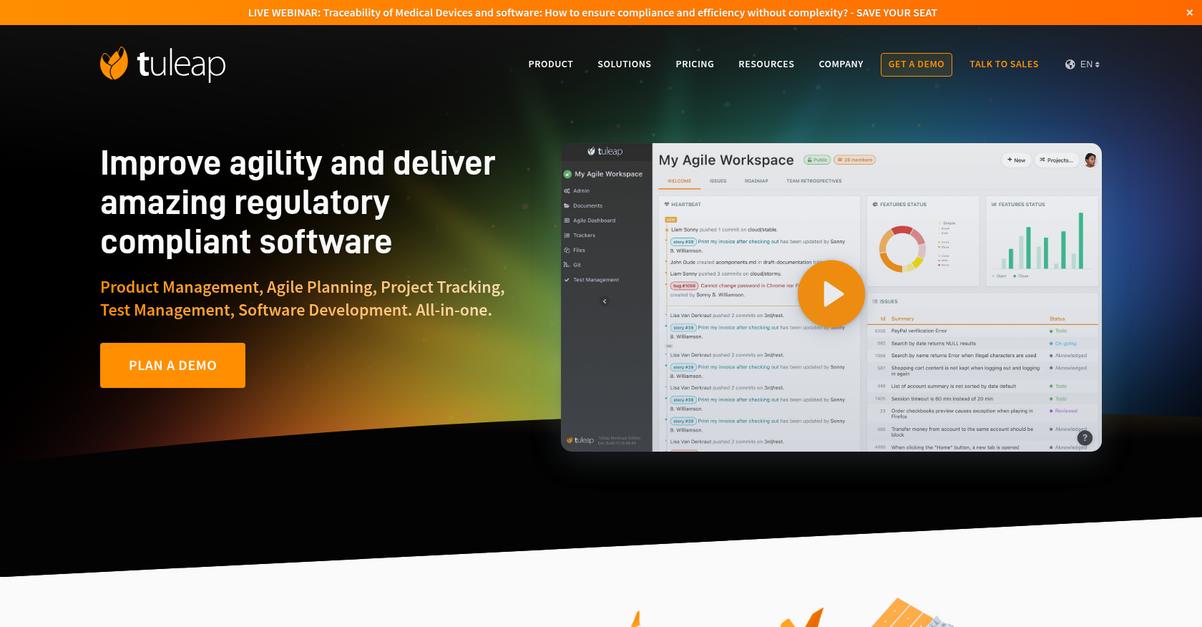
Struggling to unify your DevOps and scale quality?
Tuleap helps you tackle fragmented development workflows with its all-in-one platform for product management, project tracking, test management, and software development. This means you can finally say goodbye to multiple tools.
I’ve seen how integrating these functions helps you streamline end-to-end lifecycle management. This approach ensures compliance and efficiency.
What if you could have it all?
Tuleap solves these challenges by providing highly-customizable tools for Scrum, Kanban, SAFe®, and DevOps, ensuring industry compliance like CMMI, SPICE, and ISO. You can plan, track, code, and collaborate on software projects all in one place. Your team can manage and run both automated and manual test cases, splitting large tests into manageable steps to find bugs early. Additionally, features like real-time charts for progress tracking, visual dashboards with various KPIs, and fine-grained branch permissions for secure development workflows empower your teams. Plus, you get source code management with Git at scale, making online code reviews simple.
Your path to unified development.
If you’re also looking into robust quality control, my article on best food traceability software covers essential solutions.
Key features:
- Agile Project Management: Facilitates starting, scaling, and succeeding with agile methodologies using drag-and-drop for stories, tasks, and requirements.
- Comprehensive Test Management: Enables managing and executing both automated and manual test cases, simplifying bug detection before issues escalate.
- Integrated DevOps Workflow: Provides source code management with Git, online code reviews, and secure development with branch permissions for end-to-end control.
Tuleap features, pricing, & alternatives →
Verdict: If you’re seeking the best Application Lifecycle Management software to unify your DevOps and scale quality while ensuring compliance, Tuleap offers an all-in-one, open-source solution. Its features for agile, test, and project management help teams like JTEKT and STMicroelectronics achieve full control and accelerate software development.
7. Visure Solutions

Struggling with fragmented development workflows?
Visure Solutions offers an AI-powered Requirements ALM Platform to centralize and unify your entire application lifecycle. This means you can manage requirements, risks, and tests in one place, ensuring compliance and accelerating timelines.
Their platform allows you to gain end-to-end traceability from requirements to source code, which is critical for reducing rework and project delays. The result is a unified approach to development.
Here’s how Visure Solutions solves these challenges.
Their tool suite, including Requirements ALM Platform, Quality Analyzer, and Report Manager, provides comprehensive features. You can manage requirements history, enforce change management, and perform impact analysis.
Additionally, Visure integrates with tools like Jira, IBM DOORS, and Azure DevOps, so you don’t have to change your existing tools. This enables you to continuously customize and sync traceable information across your engineering ecosystem. Plus, with capabilities like automated checklists and a tool qualification package, you can streamline processes and meet industry standards like ISO 26262 and IEC 62304.
This empowers your team with speed and quality while lowering risk.
Key features:
- Requirements ALM Platform to manage your entire application lifecycle, offering comprehensive requirements, risk, and test management.
- End-to-End Traceability for generating traceability matrices and impact analysis from requirements to tests, defects, risks, and source code.
- Broad Integrations supporting seamless bi-directional syncing with popular tools like Jira, IBM DOORS, GitLab, and Microsoft Word & Excel.
Visure Solutions features, pricing, & alternatives →
Verdict: Visure Solutions stands out as a strong contender for the best application lifecycle management software by offering an AI-powered, comprehensive platform. Its focus on compliance, end-to-end traceability, and integrations helps growing mid-market companies unify DevOps, reduce rework, and achieve a full ROI within the first year.
8. TechExcel
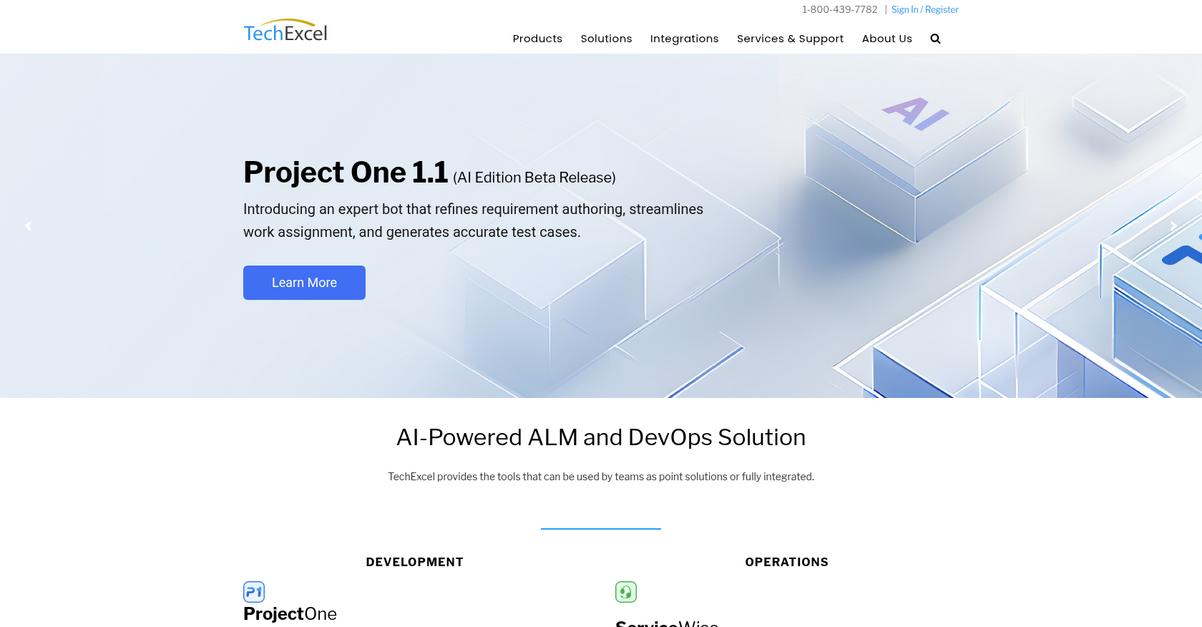
Struggling with fragmented development workflows and compliance headaches?
TechExcel’s ProjectOne platform provides total traceability, from requirements to testing, eliminating workflow gaps.
This allows you to manage requirements, track defects, and execute tests from a single platform, ensuring end-to-end lifecycle visibility for your products.
Here’s a solution that unifies your entire process.
TechExcel offers an AI-powered ALM and DevOps solution, integrating development and operations. ProjectOne streamlines work assignment and generates accurate test cases, directly impacting your team’s productivity and project quality.
Their comprehensive ProjectOne Test solution provides a robust test management and execution solution for the enterprise, allowing testing against unlimited environments for optimal coverage. Additionally, ProjectOne Spec manages requirements, while ProjectOne Track handles defect and task management with agile and traditional support, speeding up your delivery.
Achieve faster time-to-market with unified visibility.
While we’re discussing enterprise solutions, understanding best IoT software is equally important for modern businesses.
Key features:
- Total traceability: ProjectOne ALM & PLM offers a single platform for complete traceability across your product lifecycle, from initial design to deployment.
- AI-powered assistance: ProjectOne (AI Edition Beta) refines requirement authoring, streamlines work assignment, and generates accurate test cases, enhancing efficiency.
- Comprehensive testing: ProjectOne Test provides robust test management and execution, including the ability to test against unlimited environments.
TechExcel features, pricing, & alternatives →
Verdict: If you’re looking for the best Application Lifecycle Management software to streamline workflows and ensure compliance, TechExcel delivers. Their ProjectOne suite, with its AI-driven features and comprehensive test management capabilities, ensures total traceability and improves team coordination, as seen with Activision’s QA teams.
9. Rommana Software
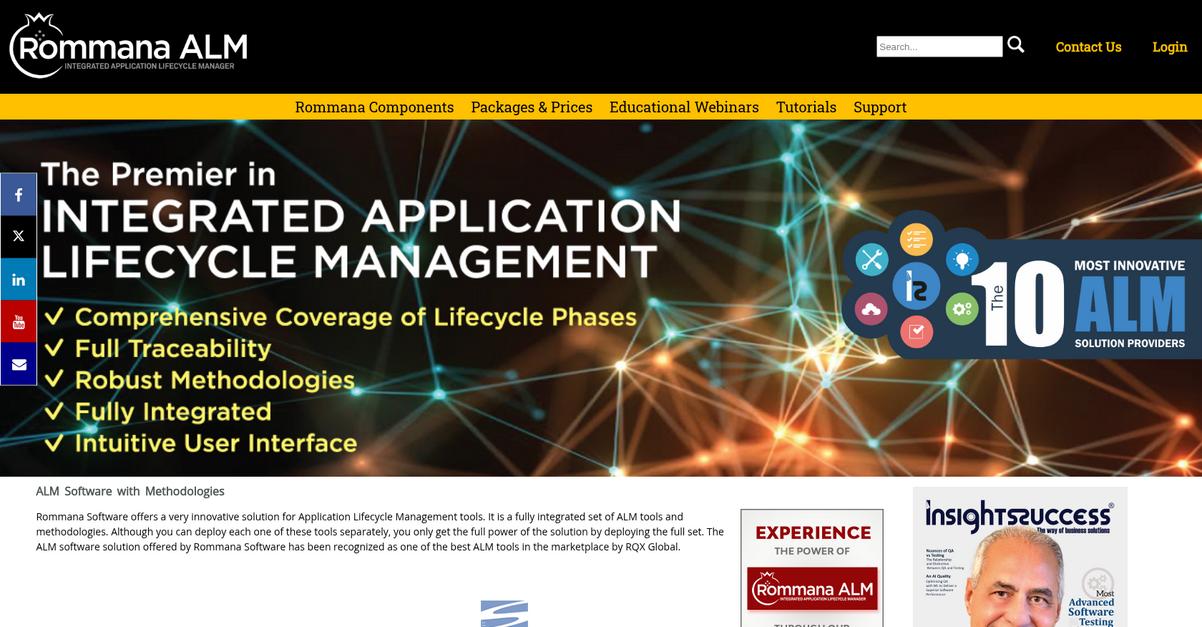
Struggling to unify your DevOps and scale quality?
Rommana Software offers an integrated suite of ALM tools to streamline your development workflow. This means you can overcome fragmented processes.
You can gain total control and integration, ensuring your project team can deliver high quality systems consistently.
Ready to transform your software delivery?
Rommana Software provides a fully integrated, web-based ALM suite with strong methodologies that guide your team through best practices. This allows for full collaboration between all team members globally, accessible 24/7. Your project artifacts and documentation) are stored in one common repository for complete traceability, from requirements to testing and bug tracking. Additionally, it offers total agility to respond to continuously changing business needs, with integrations for Jira, Bugzilla, and SVN for code version control, ensuring a unified approach. Plus, you get extensive reporting capabilities, exporting reports as Microsoft Word or PDF.
The result? Faster time-to-market.
Speaking of accelerating creativity and quality, you might also be interested in my guide on best AI design tools.
Key features:
- Integrated ALM suite: Offers a complete web-based solution for requirement management, testing, bug tracking, and project management, streamlining your entire software lifecycle.
- Total traceability: Provides full traceability from requirements through use cases, test cases, and issue reports, giving you comprehensive oversight and control.
- Global collaboration: Enables full team collaboration and 24/7 access to project data from anywhere, maximizing efficiency and communication across distributed teams.
Rommana Software features, pricing, & alternatives →
Verdict: If you’re seeking the best Application Lifecycle Management software to unify your DevOps and gain total control over your projects, Rommana Software offers a robust solution. Its fully integrated tools, strong methodologies, and total traceability can significantly enhance collaboration and project delivery, as recognized by RQX Global as one of the best ALM tools.
Conclusion
Fragmented workflows kill productivity.
Choosing the right ALM tool is tough when disconnected systems create workflow gaps. This slows your release cycles and puts quality at risk.
The constant pressure to innovate while managing outdated workflows is a huge drain on resources. It forces you to justify every new tool against tight budgets, risking costly compliance failures and project delays.
Here’s the tool I recommend.
From all my testing, Atlassian’s connected cloud platform is purpose-built to unify your entire system of work, from initial idea to final deployment.
With integrated tools like Jira and Confluence, I believe it’s the best Application Lifecycle Management software for centralizing your process. Its adoption by top companies proves its reliability for scaling quality.
For additional insights, my analysis of best GST software provides valuable perspectives.
I suggest you start a free trial of Atlassian to see just how quickly it can bring your teams together.
You will ship quality software faster.






